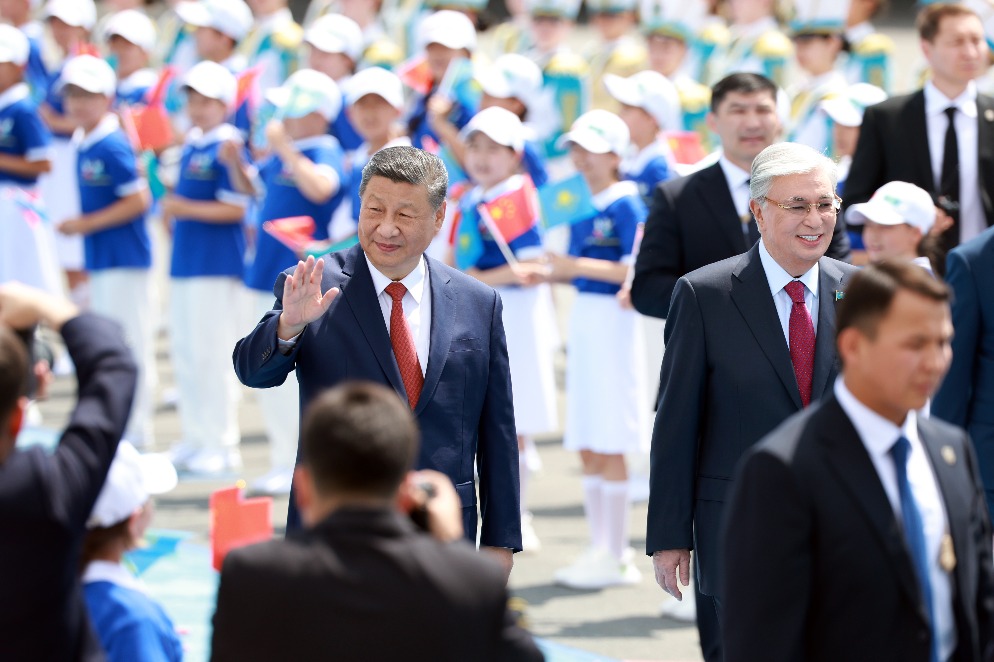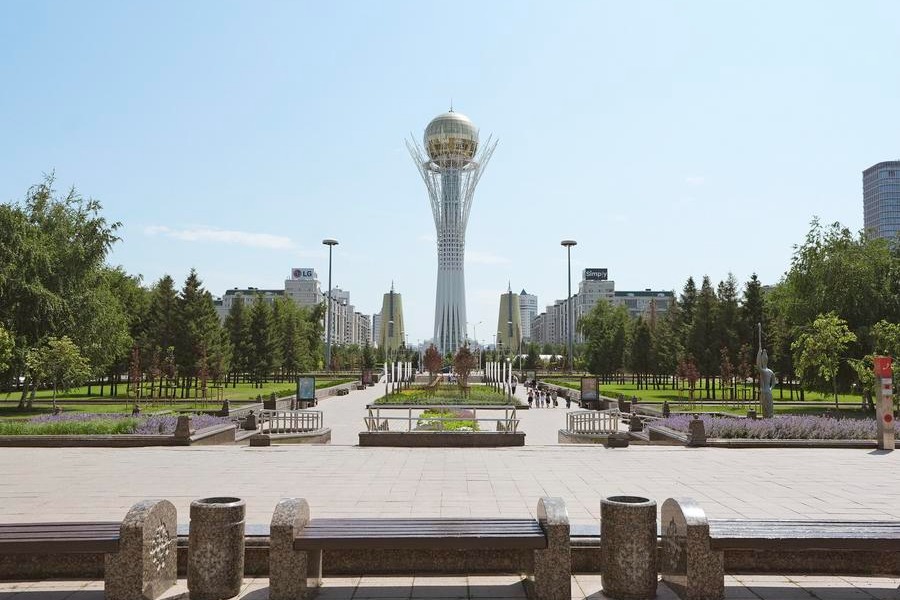Connectivity impulse


LI MIN/CHINA DAILY
Central Asian countries and China are deepening and strengthening their strategic partnership
Over the past 35 years, the relationship between Uzbekistan, other Central Asian countries and China has undergone a profound transformation. As highlighted during the virtual Central Asia-China Summit in January 2022, trade turnover and investment between China and the region have increased nearly 100-fold since 1992. Today, China stands as the largest trading and economic partner of Central Asia and a pivotal actor in the region's international affairs.
In just over a decade, Beijing has forged strategic partnerships with all Central Asian states, laying the foundation for expanded cooperation on regional and global issues.
Uzbekistan continues to advance its multifaceted partnership with China, with head-of-state diplomacy serving as a central pillar. Thanks to this high-level engagement, the relations between Uzbekistan and China have evolved from a strategic partnership established in 2012 to a comprehensive partnership in 2016, to an all-weather strategic partnership in 2024.
The frequent high-level contacts have fostered a robust political dialogue. Regular bilateral meetings are held on the sidelines of international summits.
Trade and economic cooperation remain vital components. In 2024, bilateral trade exceeded$13 billion, with ambitions to raise it to around $20 billion in the coming years. Between 2017 and 2024, Chinese investments in Uzbekistan totaled about$17.6 billion.
The opening of a regional office of the Export-Import Bank of China in Tashkent in November 2024 presents new opportunities for major joint investment projects.
Uzbekistan's strong engagement with China and other Asian and European partners was further underscored by its hosting of the Ninth Annual Meeting of the Board of Governors of the Asian Infrastructure Investment Bank in Samarkand in September 2024.
Building on this solid foundation, cooperation under the "Central Asia-China" format has gained momentum since 2020. The first summit held in Xi'an in May 2023 marked a shift from ad hoc collaboration to an institutionalized platform with regular summits, coordination mechanisms across key sectors, and a formalized cooperation agenda.
This format encompasses summits, foreign minister meetings and sector-specific councils involving ministers of economy, trade, transport, agriculture and customs. A political parties forum has been launched, along with the Central Asia-China Business Council and a joint working group on agricultural trade and economic cooperation.
The political foundation for this initiative was set by the Xi'an Declaration, outlining principles and directions for the six-party cooperation. Notably, the declaration acknowledged the importance of the consultative meeting of the heads of state of Central Asia as a key pillar for regional security, stability and sustainable development.
A growing legal framework underpins this cooperation, with memorandums signed on trade and digital commerce. Future initiatives include platforms for emergency response, education, healthcare and energy.
Humanitarian cooperation is being facilitated through networks of administrative academies, regional forums, think tanks and news agencies.
A major milestone in institutionalization was the establishment of the Central Asia-China Secretariat in Xi'an in March 2024. Xi'an, the historical gateway to the Silk Road, underscoring China's intent to strengthen ties with Central Asia.
The evolving strategic architecture of regional cooperation with China will be shaped by several key factors.
First, the ongoing process of regional consolidation, the convergence of Central Asian countries' interests, and their active engagement with major external partners. Regional cooperation is now a decisive factor in transforming Central Asia into a stable, economically and infrastructurally interconnected region, fully integrated into the global value chains.
Since the launch of the consultative meetings, tangible progress has been made in both institutional mechanisms and practical collaboration across trade, investment, transport, logistics and other domains. From 2018 to 2023, intraregional trade grew by 80 percent, reaching$11 billion. Trade facilitation levels in the region rose from 38 percent in 2017 to 67 percent in 2023.
Uzbekistan, as current chair of the consultative meeting, will host the seventh session in Tashkent this September. Key priorities include institutional strengthening, advancing economic cooperation, ensuring regional stability, and promoting Central Asia as a cohesive socio-cultural space.
An important feature of this regionalism is its openness — evidenced by expanding formats such as "Central Asia+". The region has hosted summits with the European Union and Italy, and it is hosting the second Central Asia-China Summit.
Second, China's continued rise as a global economic hub, with the global economic center increasingly shifting toward Asia. China has been the world's largest trading nation for eight consecutive years, with foreign trade hitting$6 trillion last year. Trade with the EU reached over 730 billion euros($843 billion), including 517.8 billion euros in exports. Trade with the Middle East stood at$400 billion, and with India, nearly $130 billion.
While maritime shipping dominates, overland rail transport via Central Asia is gaining ground, thanks to improved infrastructure, shorter delivery times, and the environmental benefits. Industry experts forecast sustained growth in rail logistics.
The launch of the China-Kyrgyzstan-Uzbekistan railway in 2024 was a major step in enhancing Central Asia's transit role, boosting the Trans-Caspian corridor and supporting the China-Central Asia-West Asia Economic Corridor.
Central Asia is also increasingly important as a destination for Chinese goods and investment. In 2024, trade with the region reached $94.8 billion and it is expected to surpass$100 billion by 2030. Chinese direct investments exceeded $15 billion, with $10 billion in construction contracts.
Planned projects in infrastructure, industrialization, digitalization and climate adaptation will further increase demand for Chinese equipment and capital, deepening institutional cooperation.
Third, sweeping transformations in global affairs and economic structures are accelerating the internationalization of Central Asia, stimulating deeper cooperation with China.
Security concerns — especially regarding terrorism, extremism and separatism — remain high. Stability in Afghanistan and mitigating threats from conflict zones such as Syria are shared priorities.
The restructuring of the global trade architecture brings both challenges and opportunities. Growing external interest in the region reflects its market potential and has fueled the rise of elevated "Central Asia+" formats.
Countries such as Russia, Gulf Cooperation Council states and Mongolia are actively seeking enhanced connectivity with Central Asia, spanning South Asia, the Gulf and wider Eurasia.
In this context, expanding cooperation with China may also involve leveraging other international platforms such as the Shanghai Cooperation Organization, the Central Asia Regional Economic Cooperation and BRICS+. Trilateral dialogues(for example Central Asia-Gulf Cooperation Council-China) could be valuable, especially in areas such as green energy.
These developments affirm the strong foundation and favorable conditions for advancing six-party cooperation. In this light, several priority areas are worth emphasizing.
In the field of security, in addition to ongoing cooperation within the SCO, efforts should be accelerated to establish a regular mechanism for meetings of national security council secretaries in the "Central Asia-China" format. Engagement with the SCO-Afghanistan Contact Group, including representatives of current Afghan authorities, could also be valuable.
Within the framework of transport ministers' meetings, it is essential to fast-track the development of a transport and logistics cooperation strategy, alongside initiatives for the digitalization of trade and logistics. Special attention should be given to expert dialogue on Trans-Afghan transport and energy corridor projects.
Cooperation in industrialization, digitalization and green development should become a key focus. China has made remarkable progress in modernizing its manufacturing, digital and green sectors, and is actively expanding its involvement in these areas in Central Asia. Joint projects in Uzbekistan include BYD electric vehicle production, renewable energy stations and data centers.
This calls for scaling up investment in workforce training, particularly in technical and engineering professions. China's experience could be leveraged to establish technical and innovation training centers across Central Asia and to integrate artificial intelligence and advanced technologies into local education and industries.
Expert-level cooperation between Central Asian and Chinese think tanks should be intensified. While many Central Asian research institutions already maintain strong ties with Chinese counterparts, global shifts require more structured, results-oriented collaboration. Expanding specialized platforms and involving government officials, business leaders, and civil society experts would enhance this process.
In sum, there is enormous potential for mutually beneficial cooperation between Uzbekistan, the broader Central Asian region and China across a wide range of domains. The effective implementation of joint bilateral and multilateral projects with Chinese partners will help drive economic modernization and support broader integration processes across the region.
The author is director of the International Institute of Central Asia in Tashkent, Uzbekistan. The author contributed this article to China Watch, a think tank powered by China Daily. The views do not necessarily reflect those of China Daily.
The views do not necessarily reflect those of China Daily.
Contact the editor at editor@chinawatch.cn.

































